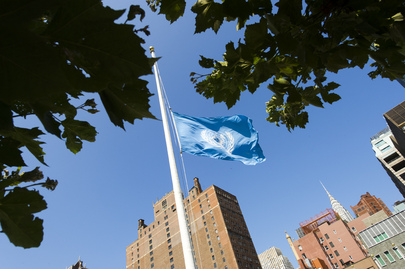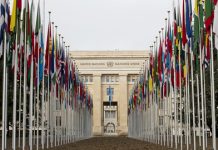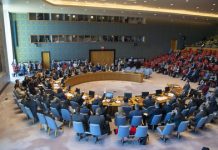He stressed that the assistance must be delivered swiftly and directly to those most in need.
He told journalists in New York that UN humanitarians were sending flour, medicines, nutrition supplies and other basic items through the Palestinian side of the Kerem Shalom crossing – a day after they managed to bring in baby formula and other nutrition supplies.
“The first trucks of vital baby food are now inside Gaza after 11 weeks of total blockade, and it is urgent that we get that assistance distributed. We need much, much more to cross,” he said, speaking from New York.
Complex aid operation
In the face of mounting international objections over the total blockade imposed on 2 March – and condemnation over the risk of widespread famine – Israel started to allow a handful of aid trucks to enter Gaza on Monday, while simultaneously intensifying its military offensive.
The aid blockade has pushed the entire population, more than two million people, to the brink of famine, amid ongoing bombardment and recurrent displacement orders.
The UN humanitarian affairs office OCHA said Israel cleared nine aid trucks to cross the Kerem Shalom border on Monday, but only five were allowed in.
Mr. Dujarric said Israel requires supplies to be offloaded on the Palestinian side of Kerem Shalom. Items are then reloaded separately once the authorities secure humanitarian teams’ access from inside Gaza.
“Only then are we able to bring any supplies closer to where people in need are sheltering,” he said.
On Tuesday, one of the UN teams waited for several hours before being given the green light.
“So, just to make it clear, while more supplies have come into the Gaza Strip, we have not been able to secure the arrival of those supplies into our warehouses and delivery points,” he said.
UN humanitarians have received permission from Israel for “around 100” more aid trucks to cross into the Strip, but they said the scale of relief efforts allowed remains entirely insufficient.
Ready and waiting
“Not enough. Five trucks, nowhere near. Not enough,” said Louise Wateridge, a spokesperson for the UN Palestine refugee agency UNRWA, in reference to Monday’s trickle of aid.
She was speaking to journalists in Geneva from a warehouse full of ready-to-be-delivered supplies in Amman, Jordan, with enough food to feed 200,000 Palestinian civilians for an entire month.
“Everything around me is aid that is supposed to be in the Gaza Strip right now,” she explained, as warehouses and distribution centres lay empty in Gaza.
“Look at what the UN could do,” she continued. “We’ve done it: the ceasefire, the bombs stopped, the supplies went in. We reached every area of the Gaza Strip. We reached people who needed it most. We reached children. We reached the elderly. The supplies went everywhere.”
Scarcity fuels looting
As aid is scarce, desperation is on the rise in Gaza, with “several predictable effects,” according to OCHA Spokesperson Jens Laerke.
“One is that the insufficient supplies are at greater risk of being looted,” he told journalists in Geneva.
He said looted products end up being sold at exorbitant prices on the black market, and opening access for large quantities of aid would automatically ease the situation.
A displaced family travels on a donkey-pulled cart carrying their belongings.
Deadly attacks and displacement
Meanwhile, hundreds have been killed in attacks in recent days, according to the Gaza health authorities.
They also report that the Indonesian Hospital was attacked on Monday, damaging electrical generators and forcing the facility to suspend services.
Fifty-five people were there as of that day, including patients and medical staff, with critical shortages of water and food.
Furthermore, an Israeli airstrike reportedly hit a school in An Nuseirat area on Monday, killing seven people and injuring others. Two UNRWA staff members were among those killed. Their deaths push the total number of agency personnel killed during the war to over 300.
In other developments: Israel issued another displacement order on Tuesday, affecting 26 neighbourhoods in northern Gaza. Overall, some 80 per cent of the Gaza Strip is now either subject to displacement orders or located in Israeli-militarized zones.
UN partners estimate that more than 41,000 people were displaced following the evacuation order on Tuesday. They further estimate that since 15 May, more than 57,000 people were displaced in southern Gaza and more than 81,000 were displaced in the north due to intensified hostilities and recurrent displacement orders.
Israeli military operations in Gaza were triggered after the Hamas-led attack of 7 October 2023. Militants killed some 1,200 people in Israel and took 250 hostages to Gaza. Fifty-eight hostages are still being held captive; 23 are believed to still be alive.
Source of original article: United Nations (news.un.org). Photo credit: UN. The content of this article does not necessarily reflect the views or opinion of Global Diaspora News (www.globaldiasporanews.net).
To submit your press release: (https://www.globaldiasporanews.com/pr).
To advertise on Global Diaspora News: (www.globaldiasporanews.com/ads).
Sign up to Global Diaspora News newsletter (https://www.globaldiasporanews.com/newsletter/) to start receiving updates and opportunities directly in your email inbox for free.
































